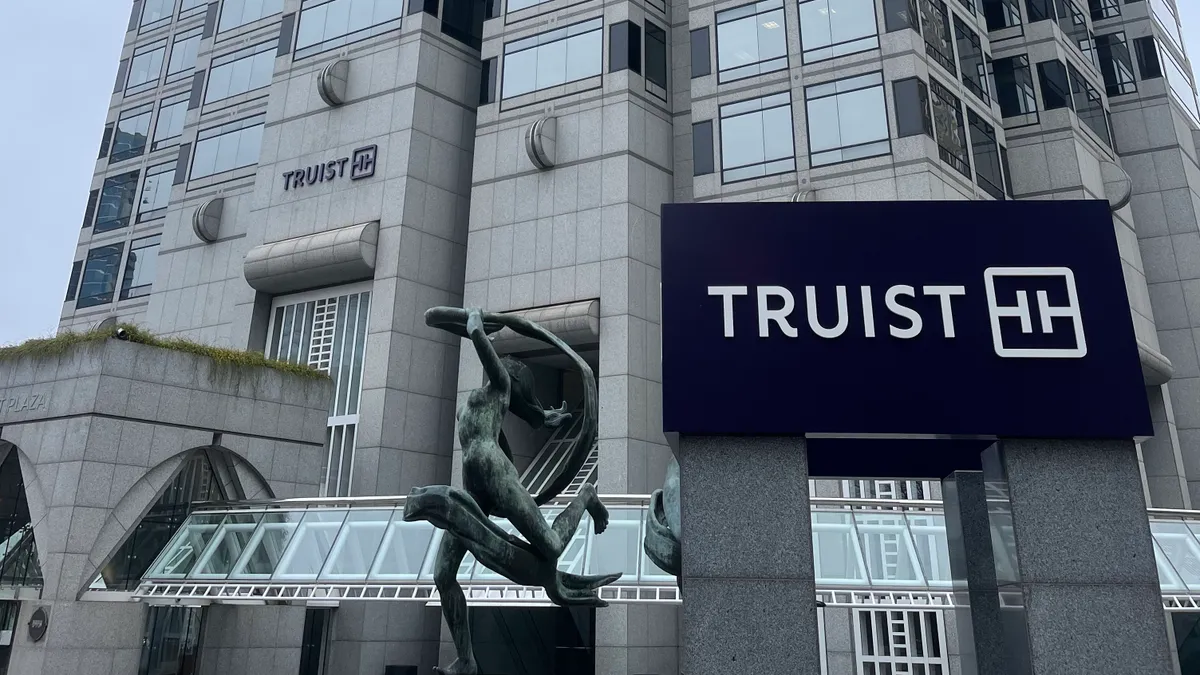Truist plans to make "sizable reductions" to its workforce over the next three quarters, as the bank embarks on a cost savings program aimed at shaving $750 million off the bank’s gross costs over the next 12 to 18 months, CEO Bill Rogers said Monday.
The job cuts alone are expected to save the Charlotte, North Carolina-based bank roughly $300 million annually, according to a presentation Rogers and CFO Mike Maguire gave during the Barclays Global Financial Services Conference. The bank expects the larger cost savings program will trim expense growth from this year’s estimated 7% to 1% in 2024.
The executives did not elaborate on the size or geographic locations associated with the planned job cuts.
A Truist spokesperson said the bank regularly assesses streamlining opportunities and makes adjustments to meet client needs.
“As we continue to transform Truist to focus on our strengths and drive long-term growth and profitability, we’re hiring in some areas and rightsizing in others through natural attrition and planned staffing reductions,” the spokesperson said in an emailed statement to Banking Dive. “We’re committed to supporting affected teammates as they seek to find employment opportunities — with Truist or elsewhere.”
Other cost savings initiatives include aggressively managing third-party spend, further reducing the bank’s corporate real estate footprint and rationalizing tech spend, Rogers said.
The initiative comes as Truist, which was formed after the 2019 merger of BB&T and SunTrust, missed second-quarter profit estimates as the bank boosted its provision for credit losses.
Since the $28 billion deal closed, the bank has been under pressure to cut costs and achieve efficiencies — post-merger benefits that executives said would come from combining the two institutions’ technology, personnel and branch networks.
At the time of the merger’s announcement, bank executives had pledged the deal would achieve $1.6 billion in annual net savings by early 2022, but systems integrations and branch consolidation delays forced executives to revise that target. The bank said it eventually hit its goal at the end of 2022.
“I’m highly aware that our financial performance has not met all of your expectations,” Rogers said Monday. “It has not met mine, either.”
But Rogers said Truist has been cautious since the close of the transaction, intentionally taking a “do-no-harm approach” in an effort to minimize disruption to customers and staff.
“We needed to be absolutely certain that client satisfaction had rebounded to pre-integration levels before launching further organizational change. This is an area, quite frankly, I believe, where mergers have failed, and we just didn't want to make that same mistake,” he said. “Having said that, though, now's the time to pivot, and pivot quickly.”
Truist’s technology expense reduction plan is expected to save the firm $200 million over the next 12 to 18 months, Rogers said. The bank will save an additional $250 million as part of a restructuring effort that will consolidate certain business lines, as well as scale back the firm’s brick-and-mortar presence, he added.
The restructuring effort includes changes to the firm’s senior management structure. Truist plans to reduce its number of division heads from seven to three by the end of 2023, in a bet that fewer layers of management will enhance focus and drive efficiency.
Rogers said one-time costs associated with the bank’s cost savings plan are expected to range from 25% to 30% of gross cost savings.
“[The plan] is well underway and we're committed to a sense of urgency and accountability,” he said.
Wells Fargo analyst Mike Mayo, who has criticized Truist’s previous efforts to rein in costs as being “a little too soft,” said in a note to clients the new plan shows management “is taking tougher actions.”
“Questions remain if this is enough,” he said, according to Bloomberg.











